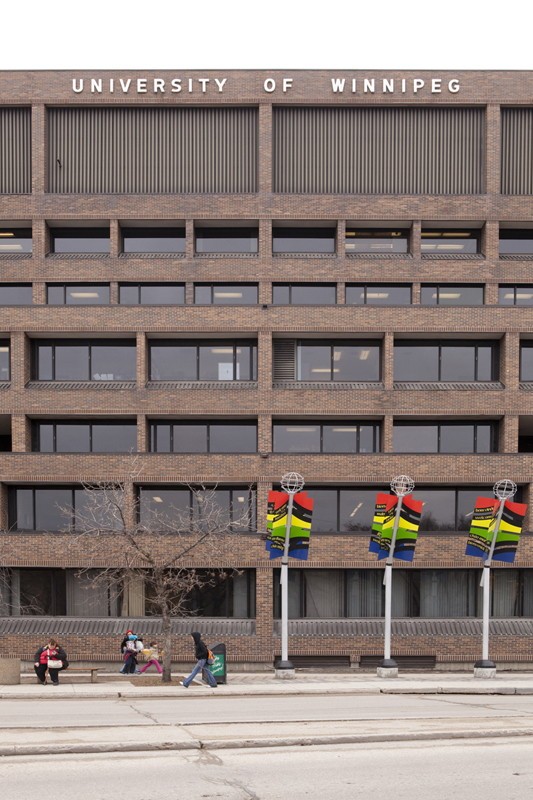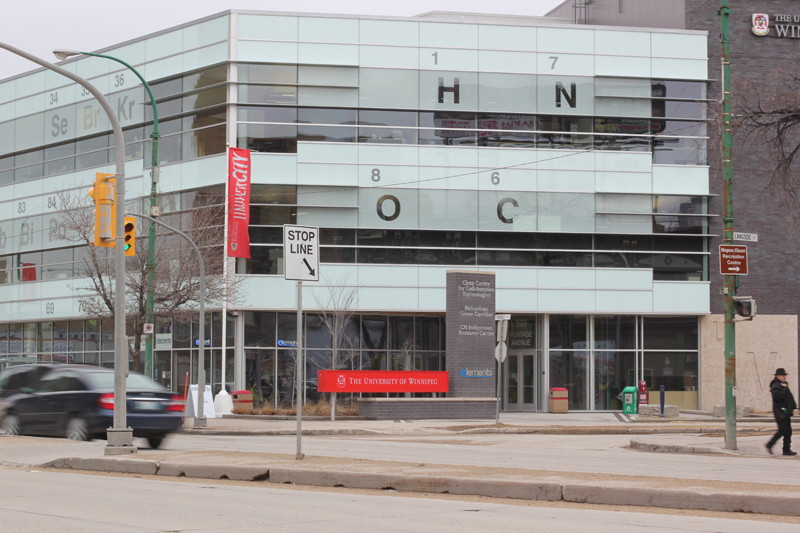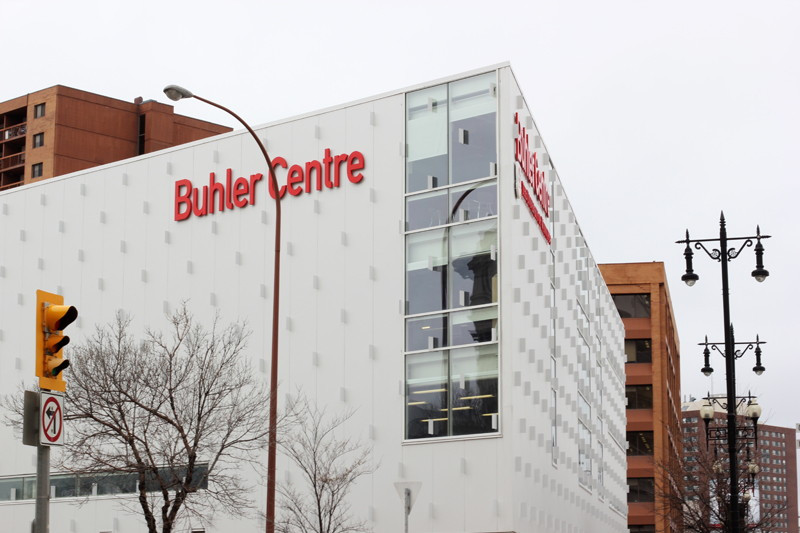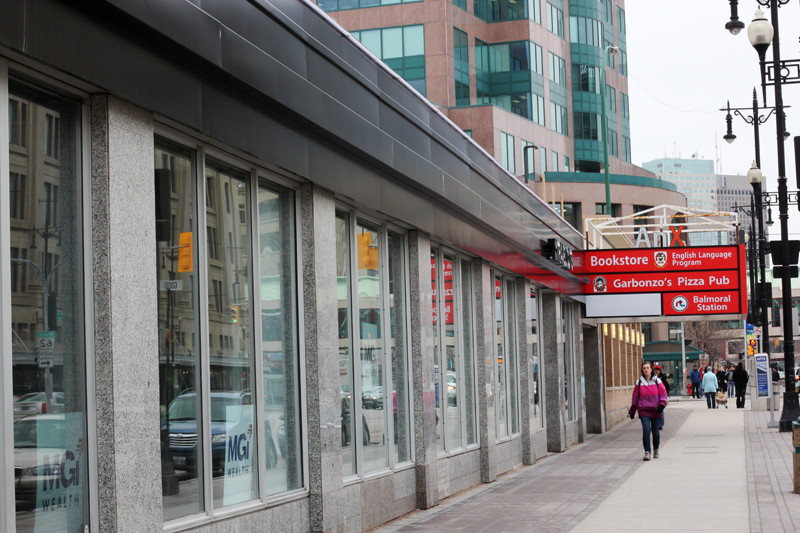University Sprawl
Photos by Dylan Hewlett and Kaitlyn Emslie Farrell
Photo Editor / Volunteer Staff
The University of Winnipeg is growing at unprecedented rates, yet still remains among the most crowded universities. As faculty cuts increase, students and professors are demanding more budget transparency, while the university demands funding equality from the province. Is the university growing beyond its means?
In the last eight years, the shape of the University of Winnipeg campus has changed considerably. With older campus buildings crumbling and a more than 50 per cent enrolment increase in recent years, a vigorous expansion plan was put in place for a campus nearly bursting at the seams.
According to a budget slideshow available on the university’s website, the university’s footprint has expanded to 1,101,000 square feet, up from 902,000 square feet in 2004. However, the student body at the U of W has increased by 55 per cent since 2000.
A 2006 study of 12 different university campuses conducted by then-associate vice president finance Doug Prophet showed the U of W had the least amount of space per student, said Bill Balan, vice-president of finance and
administration at the U of W.
Expansion projects added a theatre building, science complex, business centre and a student residence to the campus in a period of six years. However, these additions still allow only 132 square feet of space per student, keeping the university one of the most crowded campuses in the country, said Balan.
“Students are sitting in every nook and cranny because there’s nowhere for them to sit,” said Balan.
The additions have garnered criticism from students, many of whom have drawn a connection between the increase of buildings and a decrease in operating budgets.
University of Winnipeg Students’ Association science director William Ring said the expansions have left him questioning where the U of W administration’s priorities lie.
Class sizes and availability of professors have decreased as the student body expands, said Ring.
“We’re touting ourselves as a small university where you can connect with your professors, but there aren’t enough professors to actually do that,” Ring said.
Pauline Pearson, president of the University of Winnipeg Faculty Association, said that while recent faculty cuts were suspicious, she does not believe they were caused by the expansions.
Pearson does draw a potential connection between the university’s unexpectedly stringent budget and collective bargaining for the new student assistant union and the contract academic staff bargaining unit.
“Both of those units have been chronically underfunded as well, so the timing is somewhat suspect,” she said.
University budgets are far from transparent, said Pearson, which poses concerns for students, faculty and staff.
“I’m hopeful that the actions of the students and the faculty will prompt the administration to be more open and transparent, and to work together with faculty,” she said.
Allen Mills, a politics professor at the U of W, acknowledges that university expansion is necessary. However, he questions the reasoning behind erecting the $40-million athletic field house that is slated to be built on Spence
Street.
“I think the new field house is a misuse of our resources and a misuse of our priorities,” said Mills. “We need more space for students to spread out rather than play soccer.”
The university should put more effort into ensuring there are adequate teaching spaces and student resources at the university, he added.
“We need more classrooms, common rooms and general space for students to stretch.”
He added that many students who attend university are unprepared for the demands of academia, and lack the resources to succeed in their studies.
“There are many students that in some way seem to be endlessly failing - not coming to class, unable to engage in the basic kinds of academic exercises,” said Mills. “They should be given appropriate supports.”
“ We lose money on every new student that joins the university.
Bill Balan, vice-president of finance and administration, University of Winnipeg
No connection
Vice-president Bill Balan maintains there is no connection between building expansion and budget cuts.
The donations and funding the university receives for campus expansion could not be redirected to operating budgets. Funding works similarly to a trust account, he said.
“You have to account for designated funds.
Every project we created, funds had to be raised for that purpose.”
Balan added that the university avoids putting up buildings it cannot afford to operate and leases out available property in order to recoup operating costs.
Canad Inns rents space in the AnX and the university has received letters of intent from many businesses interested in field house space.
Fundraising efforts to finance construction of the buildings are funneled through the University of Winnipeg Foundation - a separate, charitable entity of the U of W founded in 2002.
A separate fundraising entity helps to ensure appropriate handling of endowments, explained foundation chair Brian Daly.
“(Administration) wanted someone independent to ensure the long-term health and viability of the endowment for scholarships and bursaries,” he said.
In 2007, the foundation began aggressive fundraising tactics for its Opportunities Capital Campaign. A goal of $135 million was set, according to Daly.
That goal was reached in September 2011, at which point the campaign ceased operations.
Approximately $83 million of the total was gained through fundraising, with an additional $51 million from government grants, gifts in kind and sponsorship, said Daly.
This funding was meant for several different areas of development, including facilities and infrastructure, student awards and academic enhancements.
A strategic review completed by the previous administration had identified funding priorities. Improved student residences and facilities for science and theatre students were among the needs identified, and projects were
created for these expansions.
The Asper Institute for Theatre and Film was in use by September 2008. In fall of the following year, students moved into the new McFeetors Hall residence. The Richardson College for the Environment and Science Complex opened in June 2011.
The expansion plan continued, with additions of the Buhler Centre, the AnX and the soon-to-be constructed Field House and Health and Wellness Centre.
Funding issues
According to Balan, a rapid increase in student enrolment has put strain on the university’s already shaky budget. This is exacerbated by a provincial funding disparity between the U of W, the University of Manitoba and Brandon University.
The U of W applied for funding when it received its charter in 1967. At the time, the province had a lower budget available for funding post-secondary institutions, said Balan.
The province therefore negotiated a low rate for the university.
Comparatively, the U of M and BU applied for funding at a time when the province had more money available in the budget, said Balan.
Policy on provincial funding for post-secondary education ensures that every institution gets the same percentage increase of funding, regardless of enrollment growth, he said.
In the past 10 years, the U of W student body has grown by 55 per cent, while the U of M has increased enrollment by 29 per cent and BU enrollment has grown by 16.4 per cent.
“We lose money on every new student that joins the university,” Balan said.
Erin Selby, Manitoba’s minister of advanced education and literacy, said the province allocates funds per program, not per student.
Some programs at the U of M and BU are more expensive to run, said Selby.
“Not all programs cost the same. If you’re offering medical programs, dentistry, those programs cost more, nursing costs more,” she said.
Since 1999, the U of W has received a 95 per cent increase in its operating grant, and $120.5 million in capital, Selby added.
“Certainly universities decide how they’re going to spend (the funding). We’ve got to live within our means,” she said.
Last year, the province began a program to increase funding to all universities by five per cent each year for the next three years. The predictability of the funding increases allows universities to plan ahead, said Selby.
Published in Volume 66, Number 26 of The Uniter (April 5, 2012)










